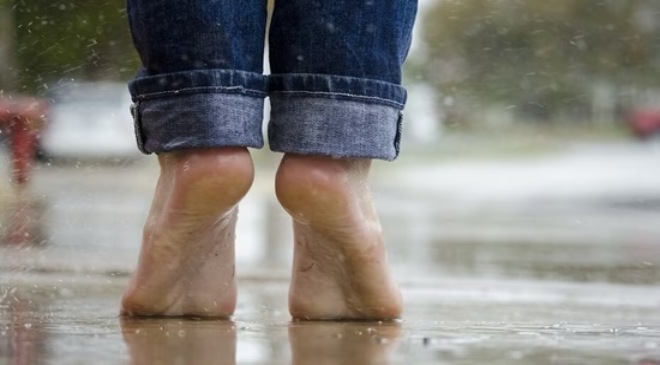Walking or working out barefoot has many benefits from reduced inflammation, improved sleep, to decreased stress levels. Here’s how to start this practice.
Ever tried walking without shoes? The direct touch of your foot on a surface not only feels soothing and relaxing but it also has a range of benefits for your heart health, blood pressure and may help keep at bay foot pain and conditions such as plantar fasciitis. Also known as grounding, the proponents of this practice believe that it helps connect us to the Earth’s surface and restore a natural electrical balance in the body. Walking or working out barefoot has many potential benefits like reduced pain and inflammation, improved sleep, immunity, decreased stress levels, and enhanced overall well-being.
Read More: Weight Loss: Follow THESE Rules to Lose Weight Without Feeling Exhausted
Walking barefoot gives you better control of the foot position and reduces the pressure of heel strike on the ground by your feet. It is also known to improve the foot arch, strengthen the muscles and ligaments of the feet and leg. When you start walking barefoot you will realise that it improves your ankle and feet’s range of motion and may also reduce stress on ankle, knee, and hip.
Beginners who haven’t tried barefoot walking before should however take it slow and first practice it for a few minutes, before increasing the time to hour or so. One should try to walk on wet surfaces like wet grass at first to make it comfortable for your feet.
Lalchawimawi Sanate, PT, LCCE, Senior Physiotherapist, Cloudnine Group of Hospitals, Sahakarnagar Unit, Bengaluru talks about benefits of walking barefoot for your physical health, foot conditions and mental health.
Read More: Fatty liver: Harmful habits that cause it, ways to manage it in early stages
Benefits of walking barefoot
- Improves foot arch and gives you less chance of developing flat feet by improving the strength of the muscles and ligaments which later prevents you from a condition called plantar fasciitis.
- Improves circadian rhythm, our internal 24 hours biological cycle which takes care of our physical, mental, and behavioural changes throughout the day, and also important things like sleep, hormones, body temperature, emotions, etc.
- By walking barefoot, you are relieving yourself from causing foot deformities like bunions that happen due to ill-fitted shoes, or claw feet caused due to wearing larger-sized shoes.
- It improves sensory feedback as there are a number of nerve endings on the feet which are exposed directly to the stimuli when you walk barefoot. This help improve body awareness, proprioception, and balance.
- Walking without shoes can help make foot mechanics better by improving the foot arch, and strengthening the muscles, and ligaments of the feet and leg.
- It also helps to maintain the normal range of motion of the ankle and feet and decreases stress on the ankle, knee, and hip.
- Walking barefoot on different surfaces like grass, sand, soil, and hard surface like floors can further improve our sensory-motor development.
- Some research has also mentioned that walking barefoot helps improve prehypertension by increasing parasympathetic activity which balances the autonomic nervous system.
Tips on how to start walking barefoot
Start with small exercises
Each foot is a complex structure that consists of 26 bones, 33 joints, and more than a hundred muscles, ligaments, and tendons. It is important to start strengthening them with little exercises. Keep a small towel under your feet and try to grasp the towel with your toes. Also sensitizing with different surfaces like pressing and rolling a tennis ball or golf ball under your feet can also help.
Read More: 6 sweet fruits to satisfy your sugar cravings naturally
Start at home
Start walking inside the homes first without shoes. Walking sans shoes inside the home will improve the thickness of callus in your feet, which will make your feet ready to walk outside. Studies also prove that thick callus does not interfere with the sensitivity of our feet.
Getting ready to walk outside the house
You can start with 5-15 minutes of walking barefoot outside in the beginning. Experts suggest choosing wet surfaces over dry ones. You can walk on wet grass for best results.
Minimalist shoes
If you have been using shoes your whole life and the transition is difficult, you can use minimalist shoes which is available in many department stores. A scientific study in 2021, found that for people who made a change from normal shoes to minimalist shoes in their normal daily activities for over a period of 6 months, their foot strength improved to 60%.
Look for clean area
You must find a clean space to walk, as it should not be a source of injury or infection to your soles. After walking outside, check your feet for any injury or dirt. Thoroughly wash your feet after walking barefoot outside.
If you have any cuts or you have a health condition, consult your doctor before starting. If you are already suffering from plantar fasciitis, flat feet or weak muscles of your feet consult your physiotherapist to prepare you for walking barefoot.
Barefoot walking for pregnant women
- You can do your floor exercises barefoot like Antenatal Pilates, Yoga, belly dancing, and low-impact aerobics on the exercise mat.
- It is not recommended for you to walk barefoot outside the house during pregnancy if you have not done it before pregnancy. Instead, you can use minimalist footwear when you are walking outdoors.
- Plantar fasciitis which is a pain on the heel or sole of the feet that is experienced by 10% of pregnant women can be relieved by walking in minimalist footwear outdoors combined with strengthening exercises for your feet as they increase the strength of your feet and improve your balance during pregnancy.
How to help your toddler walk barefoot
If you have a toddler who is learning to walk, encourage the toddler to walk on different surfaces like floor, grass, sand, and soil. This will improve the sensory-motor, and proprioception and improve body awareness.
Do not rush to make your toddler wear shoes too early but mind that the surface is clean and free from sharp objects.
Studies have proved that children above 6 years who wear closed shoes for almost 8 hours a day have more evidence of flat feet than children who are wearing sandals or using a maximum of closed shoes of 2-3 hours in a day.



































